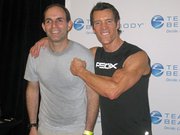
Stopwatch by wwarby (flickr.com)
I really like to learn from my productive friends, and other productivity experts. They talk about to do lists, maximum results for a task in a shorter amount of time, setting goals and achieving them, stuff like that. I have a long way to go before I could consider myself to be “productive” in many areas of my life, including the publishing frequency of this blog.
Since I have become so fitness-minded, I have noticed many of my friends share common traits when it comes to their exercise routines, too. They include exercise as an important part of their daily habits. They get on the treadmill, walking or running for a predetermined amount of time. If their pace allows, they might use that time for reading, or listening to podcasts at any speed. If they prefer to exercise outdoors, the walk or run is the perfect time to record a podcast episode, or schedule a phone call with a friendly audience, who won’t mind the breathless tone of the discussion. This seems like a great way to check off the “exercise” box on the to do list for the day, right? Another often-mentioned exercise benchmark is “10,000 steps per day” as measured by a pedometer, or about 5 miles/8 kilometers. This includes any type of walking or running, not limited to an exercise session.
I applaud the idea that any truly productive person should make regular exercise a priority in their busy life. As a matter of fact, I can speak from personal experience that I re-introduced exercise into my life years ago, when I had gained some weight in my post-college years at a desk job. I walked. I jogged. I literally wore out a treadmill to the point where it was replaced under warranty. I lost weight, ever so slowly, and I gained some back. It was frustrating.
I achieved my weight loss goal in October 2009, a few months after I got off the treadmill and changed my workout habits. I was a fan of The Biggest Loser, and I had been listening to Jillian Michaels on her radio show which was also available as a podcast feed. I decided to try her workout DVDs, which included a combination of cardio, weight training, and abdominal exercises. In addition, my friend Cliff Ravenscraft was talking about calorie counting on his podcasts, so I created an account on the Calorie Count website to see how my eating habits could be improved. I kept a tight rein on my calorie intake, and increased the amount of protein in my diet. It took me three years to lose the first 20 pounds; I lost those last 20 pounds in three months. I’ve kept off the weight, and gained muscle, ever since.
Here are my recommendations for truly productive exercise:
Focus: I’ve heard many productivity experts talk about focusing on a task to complete it in the shortest amount of time. Of course it’s possible to do certain types of exercise while watching or listening to something else, but for best results you should focus on your exercise so that it is done properly and in the most challenging way for your current fitness level. If you’re using an exercise video, watch what they are doing and follow along.
Variety: In addition to the cardiovascular benefits of walking or running, you should include weight training, High Intensity Interval Training (HIIT), and abdominal or “core” training such as yoga or Pilates. Total body workouts will produce better results than walking or running as the sole form of exercise. (If the words “high intensity” seem too scary, look for “low impact” workouts that use the same principles.)
Intensity: I’ve heard complaints that the “10,ooo steps per day” approach takes a lot of time. Similarly, long cardio sessions tend to decrease in intensity as we get tired. You’re better off to set a shorter time goal, such as 30 minutes, and go as hard as you can. For weight training, fewer repetitions of heavier weights will produce better results than lifting those light weights 100 times.
Structure: There are several exercise methods which are both time-saving and highly effective. For example, Dr. Izumi Tabata created the Tabata Protocol, which is 20 seconds of maximum intensity exercise, 10 seconds rest, repeated eight times (four minutes total exercise). This method has been modified and applied to many different workouts; for example, check out this selection at FitnessBlender. A different approach has been to combine the most effective exercises (based on research studies) into a scientifically proven exercise circuit. A third example is the so-called Manmaker Workout, which is an advanced exercise sequence combining upper body, lower body, strength training, core, and cardiovascular effort.
So if you want to accomplish your exercise goals, save time, and get better results, explore some of the workouts available at websites such as FitnessBlender or HASfit, just two of the free workout websites I have featured in my Free Workout Fridays series. I’ve also written about when to pay for a workout program. If you have any questions or comments, please leave them below or on the Facebook page.



Great post Fred. I totally agree… 10,000 steps take a long time. It is so worth it though, on the days that I am successful with that goal. Benefits extend beyond fitness and health. Often the best time I spend each day is during those walks. 🙂
Thanks @GSPN:disqus! 🙂 As I said in the post, I spent so much time on the treadmill myself, that I am trying to get the message out to try other forms of exercise. I agree that walking has many benefits. It’s all part of that balanced life thing I’ve heard about somewhere…
Hi Cliff! I loved hearing your progress in PABL podcast 570 (link below for those who might want to check it out). Keep up the good work!
http://gspn.tv/fitness/